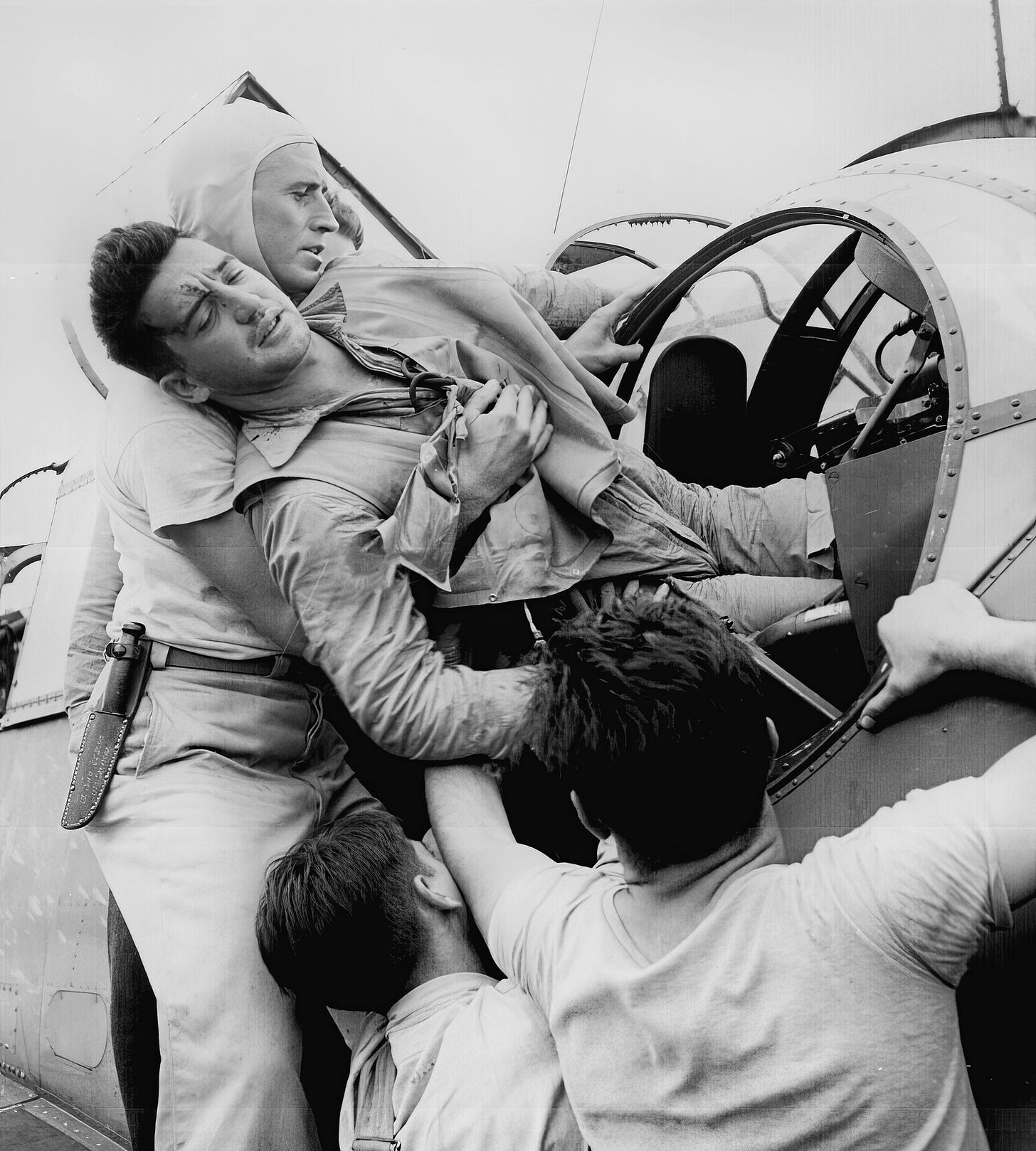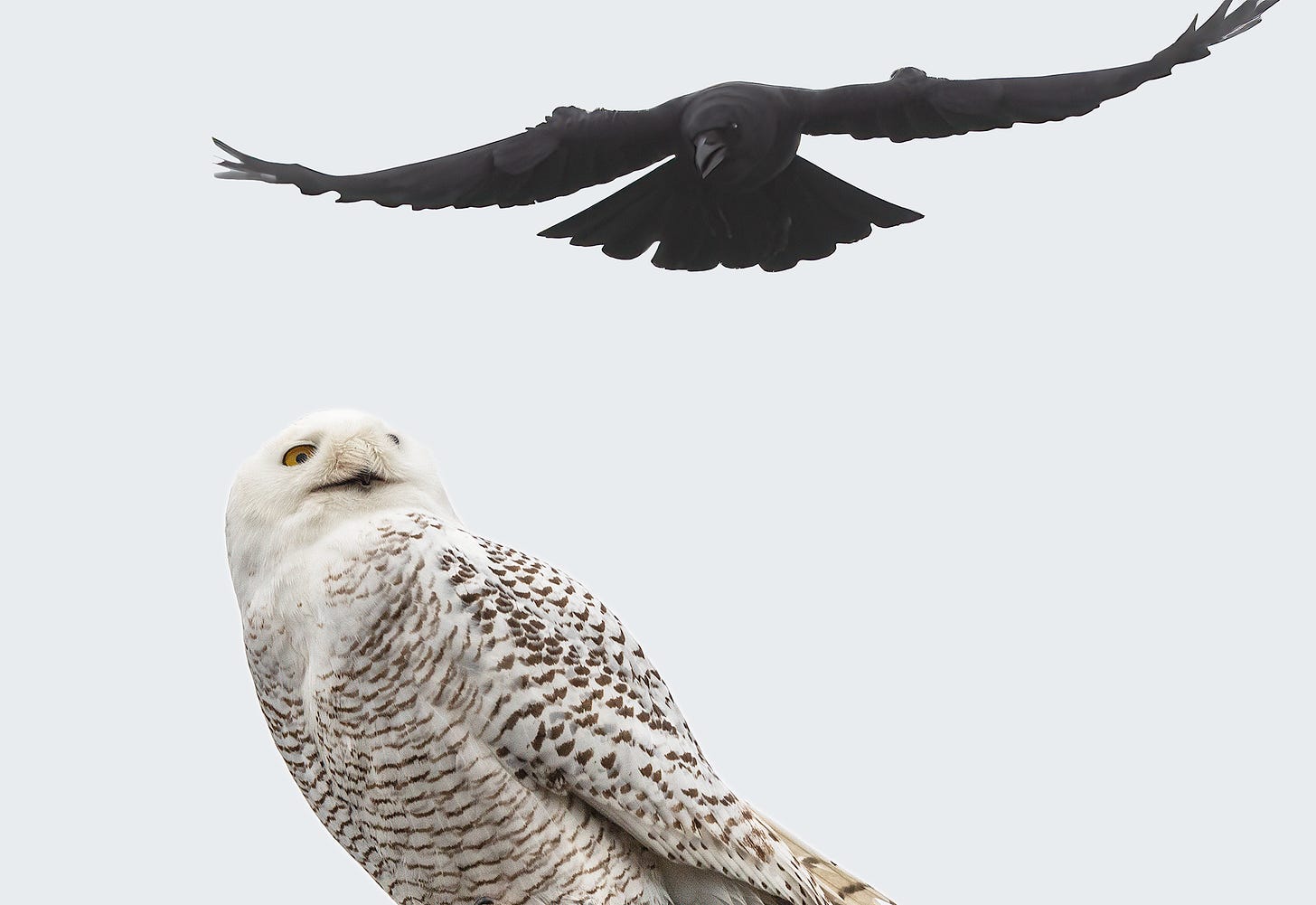Black and white
Fighting birds, the funeral of Lat Conerly, and troubles in The Family of Man. Plus: alphabets!
BIRDS
Old enemies
LAST WEEK, it snowed for the first time this season. And two years ago, almost to the day, a Snowy Owl landed outside my window. A Snowy Owl hadn’t been recorded in Port Townsend, where I live, for a decade. Unfortunately, I didn’t see it outside the window. Instead, a friend and expert birdwatcher, emailed me about it. By then, the bird had moved a few blocks away to a neighbor’s roof, so I grabbed my gear and ran down there. For the next hour, a group of a dozen crows took turns dive-bombing the owl, as they do, and noisily. Crows hate owls and always have (stories go back millennia). The owl, as owls do, acted unperturbed, though it kept an eye out and occasionally ducked the incoming crows’ outstretched claws. My friend later sent me a snapshot of the owl on my roof at home, which he found amusing—the owl, he suggested, had stopped by for a portrait session. I felt a little sheepish. I had, after all, heard the crows squawking outside my house that morning. I should have known the ancient game was afoot.
EXHIBITS
I’M PLEASED TO report that my photograph Red-tailed Tropicbird won Second Place in the annual Washington statewide awards for photography and digital art hosted by Collective Visions Gallery in Bremerton. The exhibition runs until February 23 at CVG, 331 Pacific Avenue, Bremerton, Washington.
LINDA OKAZAKI’S son, Miles Okazaki, a celebrated New York guitarist, will perform on February 2nd at 7pm at the Bainbridge Island Museum of Art in connection with her retrospective, Into the Light. Linda will be in conversation with Chief Curator Greg Robinson, and will sign her new book published by the museum on February 4th at 3pm. (I wrote the introductory essay for the book.) The exhibit runs through February 25th at BIMA, 550 Winslow Way East, Bainbridge Island, WA.
THE REGIONAL EXHIBIT of fiber artists, Burst of Color, has been extended through the end of February at Northwind Arts Jeanette Best Gallery, 701 Water Street in Port Townsend. Barbara has two quilts in the exhibit, Imaginary Sponges and Ratcheted Mandala for Hildegard.


WHAT’S BARBARA THINKING?
Lat Conerly’s funeral
MY MOTHER DIDN’T tell us many stories about her childhood, except to make it clear that we kids Had It Easy and she’d Had It Hard. As she aged, however, a previously hidden memory would sometimes surface.
When she was in her seventies, Mother had a stroke. I went to her home in Alabama to look after her and brought along an audio tape of To Kill A Mockingbird. My mother had never met the author, Harper Lee, but had often claimed a kind of regional ownership of her, as they’d both grown up in small Alabama towns about 30 miles apart and Harper was just a few years younger. Mother loved the book and hadn’t read it in decades, so I was able to convince her to listen to it with me. The fact that it had been a bestseller and a Pulitzer prize winner added further gloss to the deal.
We listened over coffee in her living room, occasionally stopping the tape to discuss the book. She reminded me again of the similarity between Harper’s hometown of Monroeville and her own town of Jackson. But as the tape rolled, what struck me was the uncanny resemblance between the character of Scout and my mother’s childhood self—little girls from single-parent households who noticed a lot but didn’t understand large chunks of their world, kids often left on their own yet encouraged to be bold and self-reliant.
During a silent moment as I switched to the next tape, Mother suddenly started talking about her father, Lat Conerly, who died when she was about Scout’s age. His death in 1931, during the Great Depression, was unexpected. He’d been in his early fifties and was thought to be a healthy man. He was also the sole breadwinner for his wife and five children.
The funeral took place in the family home. Though mourners had begun to gather in the yard, my grandmother had shut herself up in the bedroom and wasn’t talking to anyone. The house was in disarray and the children scattered. The aunts and uncles— and there were many—had gathered chairs from various households. Nobody appeared to be in charge.
My mother, aged nine, looked around for signs of what to do. The problem that seized her mind was that of the mourners outside and the empty chairs inside. She could help! She could show her father’s friends to their seats. And who knew her father’s friends better than she did? He’d taken her to the lumber mill where he worked and introduced her to Jubal and Booker. He’d taken her fishing and made sure his pal Davis brought the bait worms. He even took her with him when his friend Whit was sick and together they’d brought his family the medicine he’d needed.
She went out into the swept dirt yard and began to lead people in. Listening to my now elderly mother talk, I had no doubt that even as a young girl, she’d been a person sure of how to proceed. Jubal and Booker, hats in hands, sat down rather nervously. Whit and his wife seemed to resist her directions for a moment, but then followed as well. Only Davis Clemens seemed to come without question, but then hesitated when she indicated the seat between Whit and Jubal. Davis bent down low and hissed: “Claire! These people can’t sit here! Take them back outside and bring the white folks in!”
This directive baffled my mother. She’d merely been trying to seat her father’s friends first. But suddenly the rest of the aunts and the uncles descended and her daddy’s friends with dark skin were outside and her daddy’s friends with white skin were inside, sitting on the borrowed chairs.
Mother couldn’t remember many other details. She couldn’t remember whether there was music, or who spoke, or how long it lasted. What endured was her conviction that her father would have approved of her seating arrangements.
—Barbara Ramsey

PHOTOGRAPHY
Family sniping
I READ SOMETHING recently that I wish I could have shared with my late friend Wayne Miller. Wayne helped Edward Steichen organize The Family of Man photography exhibit at the Museum of Modern Art in New York in 1955. The Family of Man ultimately traveled to thirty-seven countries and was seen by nine million people—more than any photography exhibit before or since. When I was growing up, my family owned the book. So I was pleased to see a chapter on the exhibit in Louis Menand’s recent book on the cultural history of the Cold War, The Free World. And I was surprised by a revelation about the the exhibit’s critical reception.
Prior to The Family of Man, Wayne had served for three years as a member of a WWII Navy photo unit organized by Steichen. He was one of the first to enter Hiroshima after the bomb was dropped, one of the many horrors of war he photographed. Late in his life, I helped Wayne design an exhibit at UC Berkeley and I wrote the introduction to a retrospective of his photography. He told me that, like many returning from the war, he felt—ardently felt—that he had to “create something good from what he had learned in hell.” The Family of Man was born of that impulse. It was meant to show that we are the same under the skin, one human race. But despite its popularity, or perhaps because of it, critical theorists went on the attack.
A critique that set the tone was written by the French intellectual, Roland Barthes. His review of the The Family of Man was included in his 1957 book Mythologies, which made him famous and influenced Susan Sontag, who echoed his view two decades later in On Photography, another canon for critics. In The Free World, Menand summarizes the main point: “Barthes’s complaint about The Family of Man was that the show ignored the existence of injustice and exploitation in the name of what, for people suffering from those things, amounted to a spurious notion of human commonality.” Menand calls this reading “perverse” and cites evidence that Barthes wrote his review without actually seeing the exhibit. In fact, The Family of Man had many photographs that addressed injustice, including ones from the Shoah at a time when France had yet to come to terms with its role in the slaughter. During its tour of Japan, to cite another example, the exhibit displayed images of Hiroshima bomb victims.
In recent editions of Wild Things, I’ve written about a few photographers I’ve known, including Peter Magubane, who survived great personal risks and pain to bear witness to South African apartheid, and Czech photographer Viktor Kolář, who endured communist repression to document the Dickensian city where he lived, and Wayne, who watched men burn in the sea from kamikazi attacks that narrowly missed his own ship. Like novelists, these photographers and others like them have revealed the human condition in ways we might otherwise fail to perceive. They were not content to view the world, let alone judge it, from a comfortable chair. From early on, photographs such as those from the Civil Rights Movement and the Vietnam War—and The Family of Man—changed the trajectory of my life and of the world, and I remain grateful for those who made them.
FOR THE LOVE OF TYPE
OF THE MANY things I’ve been called, my favorite was a nickname given me by the first Art Director of Parenting, the estimable Veronique Vienne. While working under her in the early days of the magazine, she took to calling me “Doctor Type.” In that spirit, I plan over the next few weeks to share some alphabets from the past, both beautiful and whimsical. This one is part of a Gothic alphabet—the letters M,N,O and S,T,U—painted by Giovannino de’ Grassi, a Milanese architect and artist in the 14th century. I’ve no idea what animal the T fellow is holding (a dragon?), nor who or what exactly is being impaled on the left side of the U by the fellow on the right side. And why is the human-faced creature on his foot so relaxed about it?









Barbara-Your description of your mother's seating arrangements at the funeral is so keen and moving
Kerry Tremain's writing along with the special stories from Barbara Ramsey have become my favorite anticipated reading material. These personal reflections provide a whole unknown realm of their lives which allows me to know so much more and feel like an informed, longtime friend.